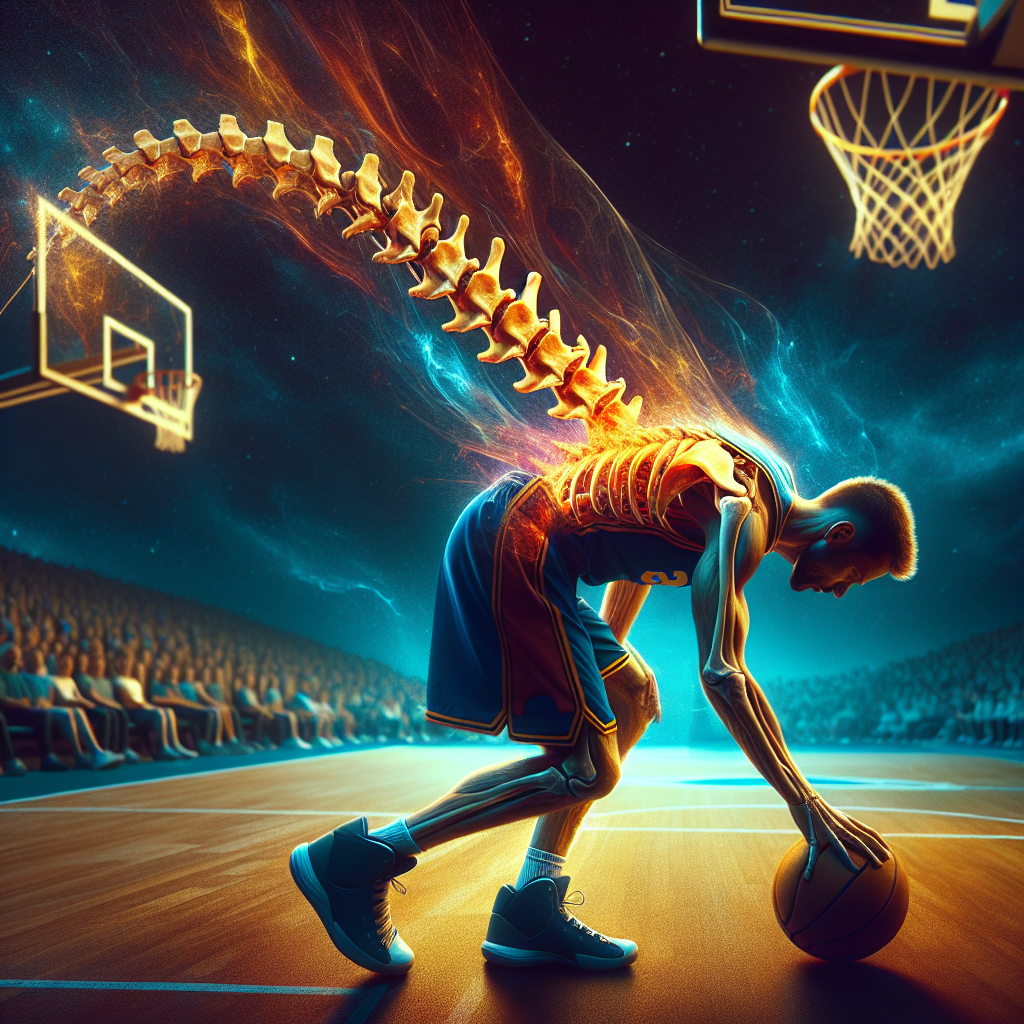Abando suffers spine injury after scary fall in KBL game

Impact Of Abando’s Spine Injury On His Basketball Career
Rhenz Abando, a promising talent in the Korean Basketball League (KBL), recently suffered a spine injury following a frightening fall during a game. This incident has sent ripples through the basketball community, raising concerns about the potential impact on his burgeoning career. As a player known for his agility and dynamic playing style, Abando’s injury not only affects his immediate ability to participate in games but also poses significant questions about his long-term career prospects.
The spine is a critical component of an athlete’s body, providing both structural support and flexibility. Injuries to this area can be particularly debilitating, often requiring extensive rehabilitation and, in some cases, surgical intervention. For a basketball player like Abando, whose game relies heavily on speed, agility, and explosive movements, a spine injury could fundamentally alter his playing style. The recovery process is likely to be lengthy and arduous, demanding not only physical resilience but also mental fortitude. This period of rehabilitation will be crucial in determining whether Abando can return to his previous level of performance or if adjustments will be necessary to accommodate any lasting physical limitations.
Moreover, the timing of this injury is particularly unfortunate for Abando, who has been steadily building his reputation in the KBL. His performances have been instrumental in his team’s successes, and he has been viewed as a rising star with the potential to make significant contributions to the league. The injury, therefore, not only interrupts his current season but also casts uncertainty over his future trajectory. Teams and scouts may now approach his potential with caution, considering the risks associated with a player recovering from a serious spine injury.
In addition to the physical and professional challenges, Abando’s injury also has psychological implications. Athletes often face mental hurdles when dealing with significant injuries, including anxiety about re-injury and concerns about their ability to perform at their previous level. The pressure to return to the court can be immense, and managing these expectations while focusing on recovery is a delicate balance. Support from medical professionals, coaches, and teammates will be essential in helping Abando navigate this challenging period.
Furthermore, this incident highlights the broader issue of player safety in basketball. While the sport is not typically associated with the same level of physical contact as football or rugby, the risk of injury remains ever-present. The KBL, along with other basketball leagues, may need to reassess their safety protocols and consider additional measures to protect players from similar incidents in the future. This could include enhanced training on fall techniques, improved protective gear, or even modifications to game rules to minimize risky situations.
In conclusion, Rhenz Abando’s spine injury is a significant event with far-reaching implications for his basketball career. The path to recovery will be challenging, requiring a comprehensive approach that addresses both physical rehabilitation and mental well-being. As the basketball community rallies around him, there is hope that Abando will overcome this setback and continue to make his mark in the sport. However, the incident also serves as a poignant reminder of the inherent risks athletes face and the importance of prioritizing player safety in competitive sports.
Safety Concerns In KBL: Lessons From Abando’s Fall

In a recent Korean Basketball League (KBL) game, the sports community was shaken by a distressing incident involving Rhenz Abando, a prominent player known for his agility and skill on the court. Abando suffered a spine injury following a frightening fall, raising significant concerns about player safety within the league. This incident has sparked a broader conversation about the measures in place to protect athletes from such potentially career-threatening injuries.
The fall occurred during a high-stakes match, where Abando, in an attempt to execute a defensive play, lost his balance and landed awkwardly. The immediate reaction from teammates, opponents, and spectators was one of shock and concern, as it was evident that the fall was severe. Medical personnel quickly attended to Abando, and he was subsequently taken to a nearby hospital for further evaluation. The diagnosis of a spine injury has since prompted discussions about the adequacy of current safety protocols in the KBL.
Player safety is a critical aspect of any sport, and basketball is no exception. The nature of the game, which involves rapid movements, jumps, and physical contact, inherently carries a risk of injury. However, incidents like Abando’s fall highlight the need for continuous assessment and enhancement of safety measures. Ensuring that players are protected requires a multifaceted approach, including proper training, equipment, and emergency response strategies.
One of the primary areas of focus should be on the training and conditioning of athletes. Proper training can help players develop the strength and agility needed to minimize the risk of falls and other injuries. Additionally, educating players on how to fall safely and how to protect themselves during high-impact plays can be invaluable. Coaches and trainers play a crucial role in this aspect, as they are responsible for instilling these practices in their athletes.
Moreover, the equipment used by players must be scrutinized to ensure it provides adequate protection. While basketball does not typically involve as much protective gear as other contact sports, innovations in footwear and padding can contribute to reducing injury risks. Ensuring that players have access to the best available equipment is a responsibility that falls on both the league and individual teams.
In the event of an injury, the speed and effectiveness of the medical response are paramount. The KBL, like other professional leagues, must have robust emergency protocols in place to address injuries swiftly. This includes having trained medical personnel on-site during games and ensuring that they have the necessary equipment to handle a range of potential injuries. The response to Abando’s fall was prompt, but it serves as a reminder of the importance of preparedness in such situations.
Furthermore, the league must engage in ongoing dialogue with players, coaches, and medical experts to continually refine safety standards. This collaborative approach can lead to the development of new strategies and technologies that enhance player safety. By learning from incidents like Abando’s fall, the KBL can take proactive steps to prevent similar occurrences in the future.
In conclusion, Rhenz Abando’s spine injury is a stark reminder of the inherent risks in professional basketball. It underscores the need for comprehensive safety measures that encompass training, equipment, and emergency response. As the KBL reflects on this incident, it is imperative that the league prioritizes the well-being of its players, ensuring that they can compete at the highest level with confidence in their safety.
Recovery And Rehabilitation: Abando’s Journey Back To The Court
Rhenz Abando, a rising star in the Korean Basketball League (KBL), recently faced a significant setback when he suffered a spine injury during a game. This unfortunate incident occurred after a frightening fall that left fans and teammates alike holding their breath. As Abando embarks on the challenging path of recovery and rehabilitation, the basketball community is rallying around him, offering support and encouragement. Understanding the intricacies of his journey back to the court provides insight into the resilience and determination required to overcome such an injury.
Initially, the severity of Abando’s injury raised concerns about his future in professional basketball. Spine injuries, particularly those sustained in high-impact sports, can be complex and require meticulous medical attention. The first step in Abando’s recovery involved a comprehensive assessment by a team of specialists, who evaluated the extent of the damage and outlined a personalized treatment plan. This plan not only focused on immediate medical interventions but also laid the groundwork for long-term rehabilitation.
In the early stages of recovery, rest and immobilization were crucial to allow the injured area to heal. Abando’s medical team prioritized reducing inflammation and pain, employing a combination of medication and physical therapy. As the initial phase progressed, the focus gradually shifted towards regaining mobility and strength. This transition marked a critical point in Abando’s rehabilitation, as it required a delicate balance between pushing physical limits and ensuring the injury was not aggravated.
Throughout this process, Abando’s mental fortitude played a pivotal role. The psychological impact of a sports injury can be as challenging as the physical aspects, often testing an athlete’s patience and resolve. Abando, however, demonstrated remarkable resilience, maintaining a positive outlook and setting incremental goals to track his progress. His determination was further bolstered by the unwavering support of his family, friends, and fans, who provided a steady stream of encouragement.
As Abando advanced in his rehabilitation, the integration of specialized exercises became essential. These exercises were designed to enhance flexibility, build core strength, and improve overall stability, all of which are vital for a basketball player. Under the guidance of experienced physiotherapists, Abando engaged in a rigorous training regimen tailored to his specific needs. This phase of rehabilitation was instrumental in preparing him for the eventual return to competitive play.
Moreover, Abando’s journey underscores the importance of a holistic approach to recovery. Nutrition, mental health support, and lifestyle adjustments were integral components of his rehabilitation program. By addressing these aspects, Abando ensured that his body was equipped to handle the demands of professional basketball once he returned to the court.
As the weeks turned into months, Abando’s progress became increasingly evident. His dedication to the rehabilitation process paid off, as he gradually regained his strength and agility. While the road to full recovery is often long and fraught with challenges, Abando’s journey serves as a testament to the power of perseverance and the human spirit’s capacity to overcome adversity.
In conclusion, Rhenz Abando’s recovery and rehabilitation journey following his spine injury is a compelling narrative of resilience and determination. Through a combination of medical expertise, personal resolve, and community support, Abando is steadily working towards his goal of returning to the basketball court. His story not only inspires fellow athletes but also highlights the critical elements necessary for overcoming significant sports injuries. As he continues on this path, the basketball world eagerly anticipates his triumphant return, confident that his best days are yet to come.

